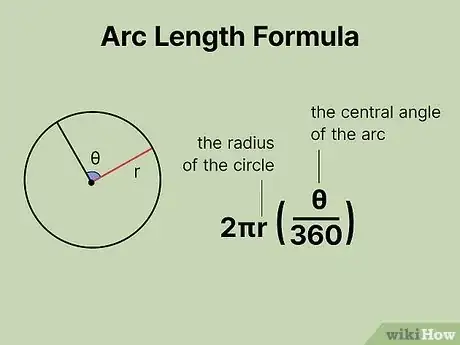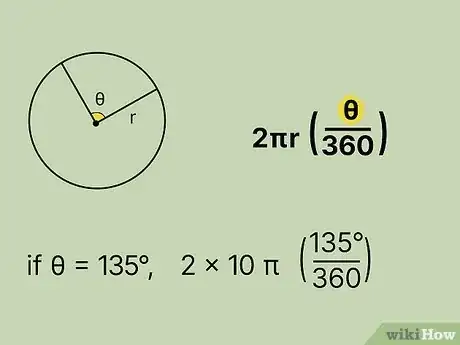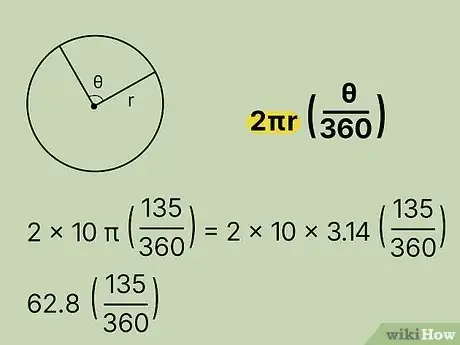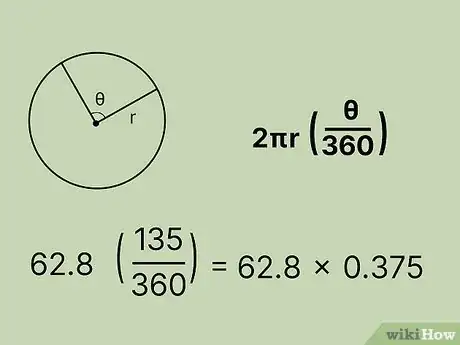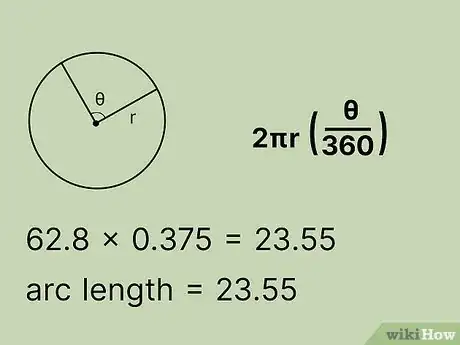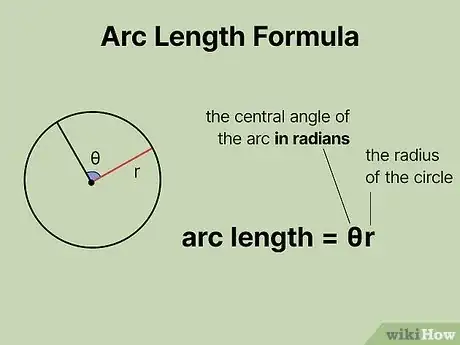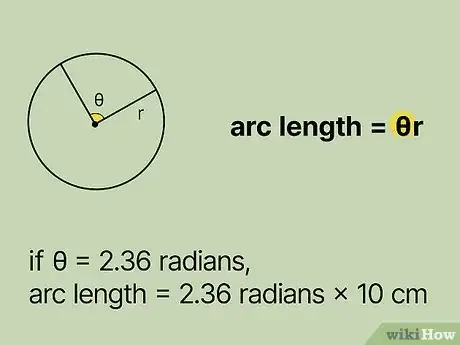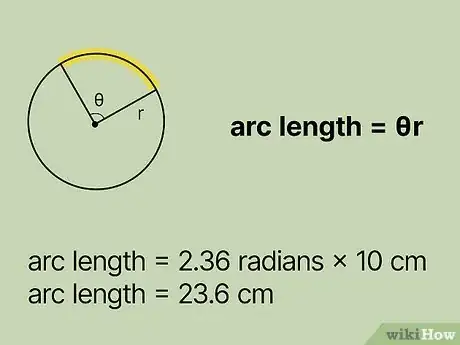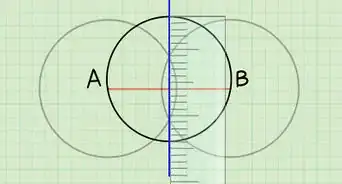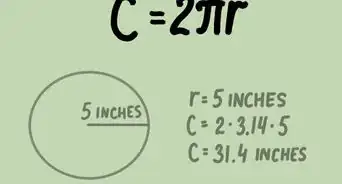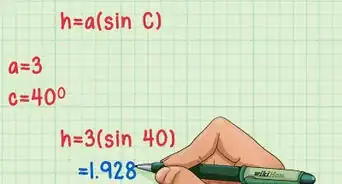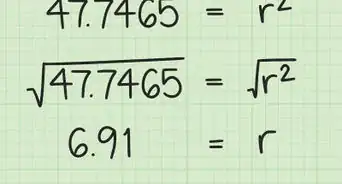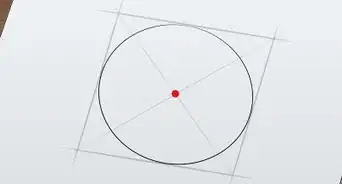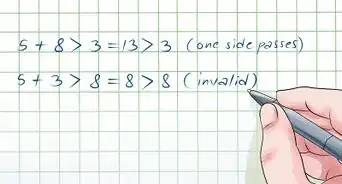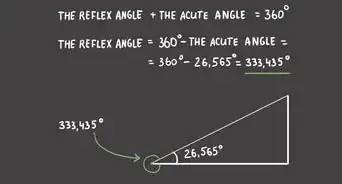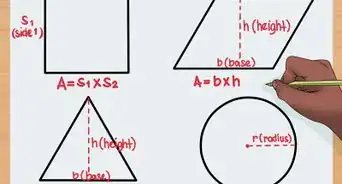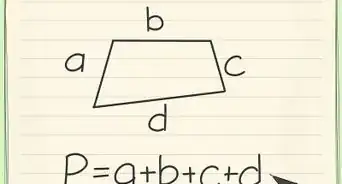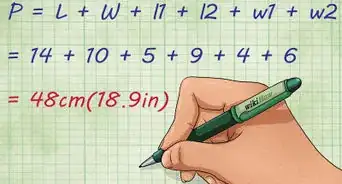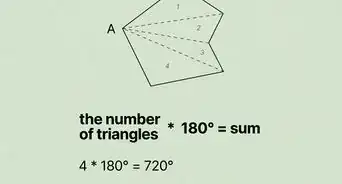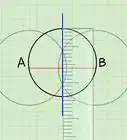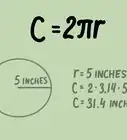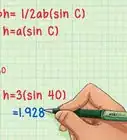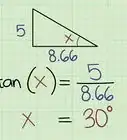This article was co-authored by Mario Banuelos, PhD and by wikiHow staff writer, Devin McSween. Mario Banuelos is an Assistant Professor of Mathematics at California State University, Fresno. With over eight years of teaching experience, Mario specializes in mathematical biology, optimization, statistical models for genome evolution, and data science. Mario holds a BA in Mathematics from California State University, Fresno, and a Ph.D. in Applied Mathematics from the University of California, Merced. Mario has taught at both the high school and collegiate levels.
This article has been viewed 842,157 times.
If you’re learning about arc lengths in geometry, your teacher probably just assigned you a bunch of problems for homework. You’ve got the circle’s radius and the central angle, so how do you find the length of the arc? Well, you’ve come to the right place! Arc length is the distance between one endpoint of an arc on a circle to the other. In this article, we’ll tell you what formulas you need and how to use them to find a circle's arc length. Read on to learn more!
Things You Should Know
- When the circle’s central angle is measured in degrees, use the formula .
- If the central angle is in radians, use the formula .
- Plug in the circle’s radius and the central angle’s measurement to solve either formula.
Steps
Solving When the Central Angle is in Degrees
-
1Set up the formula for arc length. The formula is , where equals the radius of the circle and equals the measurement of the arc’s central angle, in degrees.[1]
-
2Plug the length of the circle’s radius into the formula. This information is typically given to you in a problem. Otherwise, measure the circle’s radius with a ruler or protractor. Simply substitute the radius’ value for the variable .
- For example, if the circle’s radius is 10 cm, set up the formula like this: .
Advertisement -
3Insert the value of the arc’s central angle into the formula. Typically, the problem you’re working on provides this information. Make sure to convert the angle to degrees if it’s currently in radians. Then, substitute the central angle’s measurement for in the formula.
- For example, if the arc’s central angle is 135 degrees, your formula now looks like: .
-
4Multiply the radius by . If you are not using a calculator, use the approximation for your calculations. Rewrite the formula using this new value, which represents the circle’s circumference.[2]
- For example, your formula now looks like:
- For example, your formula now looks like:
-
5Divide the arc’s central angle by 360 degrees. Since a circle has 360 degrees total, dividing the central angle by 360 degrees gives you the portion of the circle that the sector represents. Using this information, find what portion of the circumference the arc length represents.
- For example, simplify the formula to get:
- For example, simplify the formula to get:
-
6Multiply the two numbers together. This gives you the length of the arc.
- Solve the formula:
So, the arc length of a circle with a radius of 10 cm and a central angle of 135 degrees is about 23.55 cm.
- Solve the formula:
Solving When the Central Angle is in Radians
-
1Set up the formula for arc length. The formula is , where equals the arc’s central angle in radians, and equals the length of the circle’s radius.[3]
-
2Plug the length of the circle’s radius into the formula. The math problem you’re working on typically provides this information. Just substitute the length of the radius for the variable .
- For example, if the circle’s radius is 10 cm, your formula looks like this: .
-
3Plug the measurement of the arc’s central angle into the formula. When using this formula, the arc’s central angle needs to be in radians. If the central angle is in degrees, just convert it into radians.
- For example, if the arc’s central angle is 2.36 radians, your formula now looks like this: .
-
4Multiply the radius by the arc’s central angle. The product gives you the length of the arc.
- For example:
So, the length of an arc of a circle with a radius of 10 cm and a central angle of 23.6 radians, is about 23.6 cm.
- For example:
Practice Problems and Answers
Expert Q&A
Did you know you can get premium answers for this article?
Unlock premium answers by supporting wikiHow
-
QuestionHow do you calculate the length of an arc?
 Mario Banuelos, PhDMario Banuelos is an Assistant Professor of Mathematics at California State University, Fresno. With over eight years of teaching experience, Mario specializes in mathematical biology, optimization, statistical models for genome evolution, and data science. Mario holds a BA in Mathematics from California State University, Fresno, and a Ph.D. in Applied Mathematics from the University of California, Merced. Mario has taught at both the high school and collegiate levels.
Mario Banuelos, PhDMario Banuelos is an Assistant Professor of Mathematics at California State University, Fresno. With over eight years of teaching experience, Mario specializes in mathematical biology, optimization, statistical models for genome evolution, and data science. Mario holds a BA in Mathematics from California State University, Fresno, and a Ph.D. in Applied Mathematics from the University of California, Merced. Mario has taught at both the high school and collegiate levels.
Assistant Professor of Mathematics
-
QuestionHow do l find the arc length if I'm not given the central angle?
 wikiHow Staff EditorThis answer was written by one of our trained team of researchers who validated it for accuracy and comprehensiveness.
wikiHow Staff EditorThis answer was written by one of our trained team of researchers who validated it for accuracy and comprehensiveness.
Staff Answer wikiHow Staff EditorStaff AnswerIf you're not given the central angle, you'll typically be given the sector area of the arc. To find the arc length with a sector area, multiply the sector area by 2. Then, divide the product by the radius squared ((SA*2)/r^2). Your answer gives you the central angle in radians. You now have the central angle in radians, so simply multiply the central angle by the radius to find the arc length.
wikiHow Staff EditorStaff AnswerIf you're not given the central angle, you'll typically be given the sector area of the arc. To find the arc length with a sector area, multiply the sector area by 2. Then, divide the product by the radius squared ((SA*2)/r^2). Your answer gives you the central angle in radians. You now have the central angle in radians, so simply multiply the central angle by the radius to find the arc length. -
QuestionIs the measurement of an inscribed angle half the measurement of the central angle that intercepts the same arc?
 wikiHow Staff EditorThis answer was written by one of our trained team of researchers who validated it for accuracy and comprehensiveness.
wikiHow Staff EditorThis answer was written by one of our trained team of researchers who validated it for accuracy and comprehensiveness.
Staff Answer wikiHow Staff EditorStaff Answer
wikiHow Staff EditorStaff Answer
References
- ↑ Mario Banuelos, PhD. Assistant Professor of Mathematics. Expert Interview. 19 January 2021.
- ↑ http://mathbitsnotebook.com/Geometry/Circles/CRArcLengthRadian.html
- ↑ https://mathbitsnotebook.com/Geometry/Circles/CRArcLengthRadian.html
- ↑ http://www.mathopenref.com/diameter.html
About This Article
To find arc length, start by dividing the arc's central angle in degrees by 360. Then, multiply that number by the radius of the circle. Finally, multiply that number by 2 × pi to find the arc length. If you want to learn how to calculate the arc length in radians, keep reading the article!


